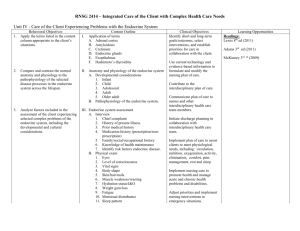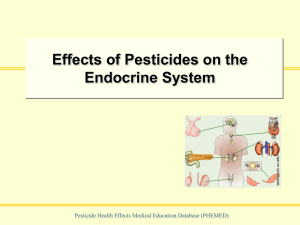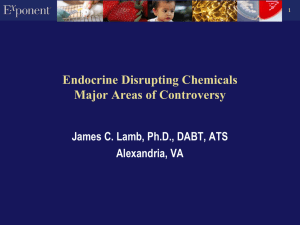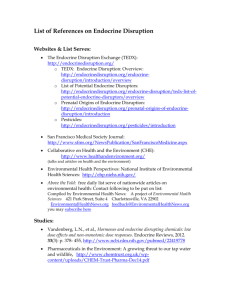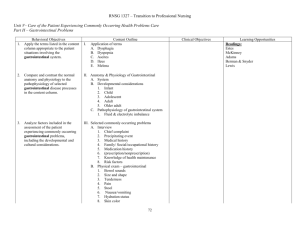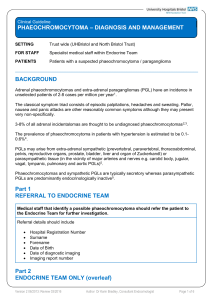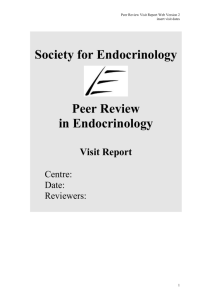Part F: Endocrine System
advertisement
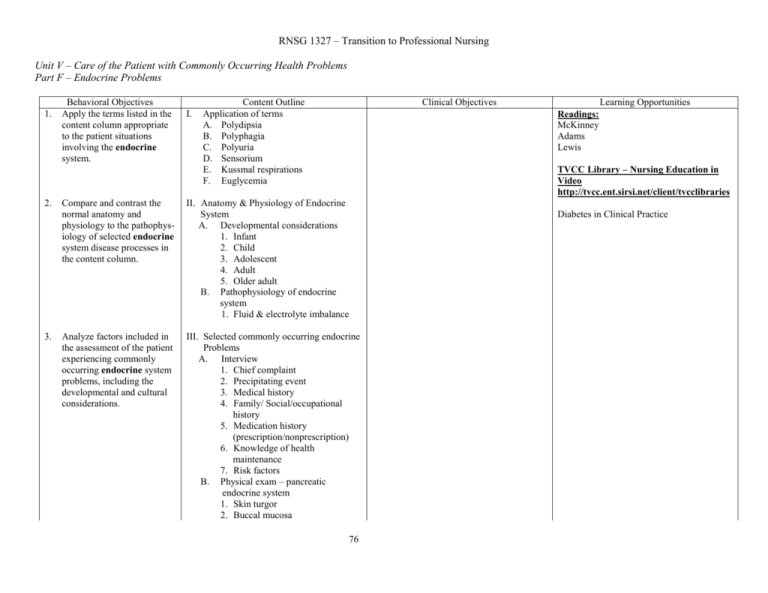
RNSG 1327 – Transition to Professional Nursing Unit V – Care of the Patient with Commonly Occurring Health Problems Part F – Endocrine Problems 1. 2. 3. Behavioral Objectives Apply the terms listed in the content column appropriate to the patient situations involving the endocrine system. I. Content Outline Application of terms A. Polydipsia B. Polyphagia C. Polyuria D. Sensorium E. Kussmal respirations F. Euglycemia Clinical Objectives Learning Opportunities Readings: McKinney Adams Lewis TVCC Library – Nursing Education in Video http://tvcc.ent.sirsi.net/client/tvcclibraries Compare and contrast the normal anatomy and physiology to the pathophysiology of selected endocrine system disease processes in the content column. II. Anatomy & Physiology of Endocrine System A. Developmental considerations 1. Infant 2. Child 3. Adolescent 4. Adult 5. Older adult B. Pathophysiology of endocrine system 1. Fluid & electrolyte imbalance Analyze factors included in the assessment of the patient experiencing commonly occurring endocrine system problems, including the developmental and cultural considerations. III. Selected commonly occurring endocrine Problems A. Interview 1. Chief complaint 2. Precipitating event 3. Medical history 4. Family/ Social/occupational history 5. Medication history (prescription/nonprescription) 6. Knowledge of health maintenance 7. Risk factors B. Physical exam – pancreatic endocrine system 1. Skin turgor 2. Buccal mucosa 76 Diabetes in Clinical Practice RNSG 1327 – Transition to Professional Nursing Unit V – Care of the Patient with Commonly Occurring Health Problems Part F – Endocrine Problems Behavioral Objectives C. 4. Differentiate between the etiology, pathophysiology, and clinical manifestations of selected commonly occurring endocrine disease processes. Content Outline 3. Intake & output 4. Level of consciousness 5. Feet Diagnostic tests 1. Laboratory studies a. Electrolytes b. Glycosylated hemoglobin c. Blood glucose d. Urine (1) Ketones (2) Specific gravity 2. Other a. Cultural influences b. Hereditary c. Environmental d. Health beliefs/practices e. Developmental (1) Age specific assessment data (a) Vital signs (b) Fluid /electrolytes (c) Nutritional (d) Behavioral/emotional response to health care providers IV. Commonly Occurring Endocrine Problems A. Pancreatic endocrine 1. Diabetes Mellitus a. Insulin Dependent Diabetes Mellitus (IDDM) (Type 1) b. Non-Insulin Dependent Diabetes Mellitus (NIDDM) (Type 2) 77 Clinical Objectives Learning Opportunities RNSG 1327 – Transition to Professional Nursing Unit V – Care of the Patient with Commonly Occurring Health Problems Part F – Endocrine Problems 5. Behavioral Objectives Discuss analysis, planning, implementation, and evaluation for the nursing management of patients with commonly occurring selected endocrine disease processes. Content Outline V. Selected Nursing Diagnoses / Implementation / Evaluation A. Fluid / Electrolyte Imbalance 1. Independent interventions a. Age related hydration status b. Monitor pertinent diagnostic tests c. Maintain skin integrity d. Intake and output e. Weight f. Vital signs g. Sensorium h. Adhere to standard precautions 2. Collaborative interventions a. Administer replacement fluids (1) Oral replacement solutions (2) Intravenous fluids (3) Electrolytes b. Administer medications and monitor for desired/side/adverse effects (1) Insulin preparations (2) Oral antidiabetic agents 3. Recognition of complications a. Hypoglycemia b. Hyperglycemia c. Long term complications of diabetes (1) Microvascular (2) Macrovascular (3) Neuropathic (4) Infections/sepsis 78 Clinical Objectives Learning Opportunities RNSG 1327 – Transition to Professional Nursing Unit V – Care of the Patient with Commonly Occurring Health Problems Part F – Endocrine Problems Behavioral Objectives Content Outline Evaluation of Outcomes: The patient will have improved fluid and electrolyte balance as evidenced by: a. Hydration status b. Improved laboratory studies c. Intake and output d. Bowel/urinary elimination e. Vital signs B. Altered health maintenance: Knowledge deficit regarding diabetes 1. Patient Teaching a. Assess readiness to learn, ability, and knowledge level b. Reportable signs/symptoms (1) Hypoglycemia (2) Hyperglycemia c. Medication (1) Insulin injection techniques (2) Oral agents d. Exercise e. Foot care f. Sick day management rules g. Dental care h. Blood glucose monitoring i. American Dietary Association (meal planning) j. Safety precautions 2. Community Resources a. American Diabetes Association b. Podiatrist 4. 79 Clinical Objectives Learning Opportunities RNSG 1327 – Transition to Professional Nursing Unit V – Care of the Patient with Commonly Occurring Health Problems Part F – Endocrine Problems Behavioral Objectives 3. Content Outline c. Home Health d. Diabetes Educator Evaluation of Outcomes: The patient will have improved health maintenance as evidenced by: a. Identifying reportable signs and symptoms (1) Hypoglycemia (2) Hyperglycemia b. Describing the purpose, correct administration and side effects of medications c. Demonstrate insulin injection administration d. Demonstrate use of blood glucose monitor e. Demonstrate proper foot care f. Adheres to prescribed diet g. Utilizes appropriate members of health care team h. Participates in prescribed exercise program i. Utilizes community resources N:\Transition/RNSG 1327 Unit V Part F - Endocrine Clinical Objectives Learning Opportunities Reviewed 03/12 Reviewed 03/13 80
